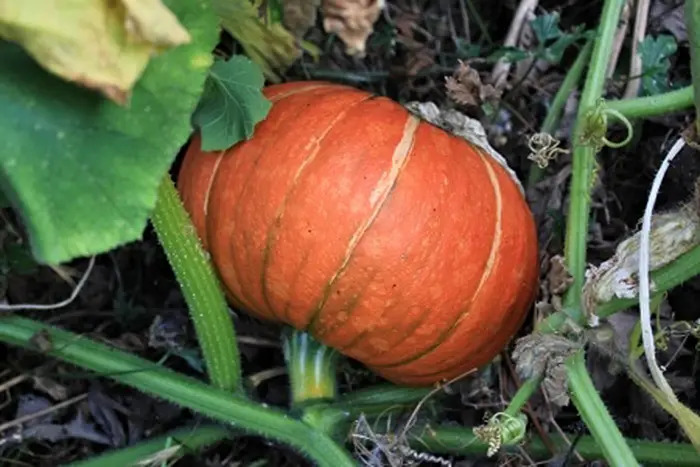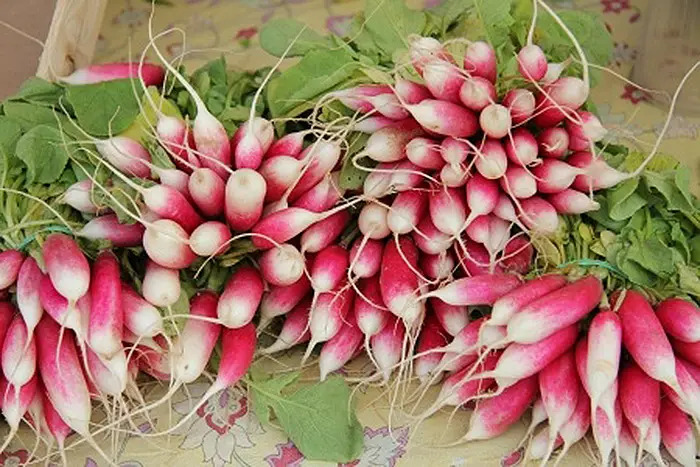Roots, Shoots, Buckets, & Boots, by Sharon Lovejoy, shares twenty plants that are ideal for your kid’s first garden. Lovejoy’s suggestion include plants with vibrant colors, fast-growing plants, and plants that are useful in everyday life. Happy growing!
When grown-ups ask me what they should plant for their children, my first inclination is to say “everything.” The truth, however, is that just a few star performers in the plant world are a must in a child’s garden.
My list of stars is short: twenty old-fashioned favorites that are more than pretty faces. They have personality, fragrance, texture, and color—vibrant color. They grow quickly—something kids need in response to their work. And they’re versatile; they can be used as jewelry, toys, clothes, musical instruments, and household utensils.
My Top 20 plants are proven winners in thousands of gardens and are all available through catalogs or nurseries.

Pumpkins win all the popularity contests. If I had to choose only one plant to introduce kids to the wonder of gardening, it would be pumpkins—all shapes, colors, and sizes of pumpkins. Mini pumpkins, like the white ‘Boo’ or the palm-size ‘Munchkin’ and ‘Jack-Be-Littles’, grow best in tubs or barrels. Giant pumpkins need room to roam and are so rambunctious that they’ve been known to engulf whole backyards.
My favorite, the flame-red ‘Rouge Vif’ d’ Etampes’, looks like an overstuffed piece of furniture—the kids in my gardens refer to this one as Cinderella’s footstool. ‘Connecticut Field’, also known as ‘Yankee Cow’, is a descendant of a pumpkin Native Americans shared with the Pilgrims.
White ‘Lumina’ looks like a full summer moon shining through a tangle of prickly leaves. Carved, it makes a great jack-o’-lantern for Halloween, uncarved, it’s a perfect white canvas for youngsters to paint with acrylics.
Sunflowers are the whimsical floral personalities in a child’s garden. ‘Giant Gray Stripe’, ‘Paul Bunyan’, and ‘Russian Mammoth’ form towering, protective walls around playhouses, castles, tents, and meandering mazes. Diminutive ‘Teddy Bear’, ‘Music Box’, ‘Elf’, and ‘Sunspot’ are kid-size (2 to 4 feet tall) and can be grown successfully in containers. The bronze and golden ‘Sundance Kid’ will never grow up—it reaches only 18 inches at maturity, which makes it the perfect choice for a child’s miniature fort or doll house planted in a shallow, wooden box.
Gourds are Mother Nature’s all-purpose plants. From birdhouses to bath sponges, drums to dolls, a garden draped in gourds can supply children with endless hours of fun and discoveries.
Small, ornamental mixed gourds are perfect hideout plants and will quickly engulf a playhouse or tepee with vines and a blaze of papery, star-shaped blossoms.
One packet of seeds will produce colorful oddities that look like apples, pears, oranges, warty monsters, and strange crowns studded with thorns. Children “treasure hunt” for the ugliest, strangest, scariest, and prettiest offspring. Luffa gourds (or vegetable sponges) are shaped like giant cucumbers, and they have as many names as they have uses. Sepium, grown best in a half-barrel, is a small luffa that fits perfectly in a child’s hand.
Plant a plot of bottle gourds and dipper gourds for a supply of winter craft projects. Tiny spoon gourds are child-size eating utensils and giant bushel gourds make perfect toy baskets. Two gourd cups connected by a long string can be used as a natural “telephone” and the longhandled gourds make great back-scratchers.
Corn is a source of wonder. Kids find it hard to believe that the needlelike seedlings that pierce the ground will someday produce exploding kernels or a whole harvest of jeweltoned ears.
Small corns, such as ‘Strawberry’ popcorn and mini Indian corn, are content to grow in close quarters, in half-barrels, and in baskets filled with rich soil and compost.
Giant ‘Six-Shooter’ corn can reach 12 to 15 feet. You’ll need to set aside at least a 10-foot plot of sunny ground for this towering veggie. Or scratch out a maze design, and plant a maze of maize with your kids.

Berries attract kids as surely as bugs attract toads. You can’t go wrong if you start a patch, fence, or border of berries for your children. In my gardens the kids spend lots of time harvesting blackberries from the back wall. If they eat too many, they’ve learned that a fine stomach-settling tea can be brewed from the leaves.
Borders or pots of Alpine strawberries are easy for kids to plant and grow. Each tiny, threadlike stem will take root and produce a compact, mounding plant dangling with ruby “earrings” of fruit.
Crushed berries produce a “paint” that children can use in art projects or for face painting. In Sweden it’s a tradition to string berries on grass or rush for edible necklaces and bracelets. Kids poke the berries with a twig, thread them onto long, thin strands of grass, then tie with a knot. By the end of the day their jewelry has been nibbled away.
Hollyhocks, with their spires of colorful, silk-skirted flowers, belong in every child’s garden. Line a fence with a planting of the perennial fig hollyhocks, old-fashioned singles, or ‘Indian Springs’, or etch a circle into the ground and plant a circular tepee as a hollyhock hideout.
These tall, graceful bloomers provide kids with a summer-long supply of materials for an array of outdoor projects, and they furnish bumblebees, butterflies, skippers, and hummingbirds with a dependable source of sweet nectar. The rainbow-hued flowers are edible and kids enjoy stuffing them with cream cheese, ice cream, or sorbet.
Children can make puppets of flowers pierced with twigs and topped with unopened blossoms. Dolls are fashioned from fresh blossoms and unopened buds, stacked on top of each other and held together with twigs. Crowns, leis, and jewelry are crafted from the blooms strung on thread.
My favorite hollyhock story was told by Millie Baker Stanley of Ohio who, as a child, used to capture fireflies and tuck them into hollyhock blossoms. She then knit the edges together with a long twig and carried them through her moonlit garden like magical fairy lanterns.
Carrots are the golden buried treasures in a child’s garden. Pots, baskets, or window boxes filled with loose soil make a perfect carrot patch. Children love the small, round ‘Thumbelina’ and ‘Parmex’, and the baby-finger-size ‘Minicors’. Kids can arrange a “bouquet” of these tiny gems by tucking them, roots down, in a clear jar or vase.
Just for fun, mix some rocks and pebbles into a container of soil. When they encounter obstacles, carrots branch into whimsical shapes. Chances are good that the kids will unearth some very strangelooking carrot-people—much too interesting to eat.
Mimosa, or sensitive plant, has almost as many names as it has leaves—shrinking Susie, touch-me-not, humble plant, shame plant, sleepyhead, and ticklish Tim for its habit of rapidly folding downward when touched. This shy relative of the pea family is beloved by all children who are fascinated by a plant that moves quickly (fastest in hot weather and bright light) in response to their touch.
The Mimosa pudica is a small plant easily grown from seed. It is perfect for container gardening. Situate mimosa in an area where children frequently play or pass through so that they can constantly interact with their Mimosa plant.
Poppies are a brilliant, carefree addition to a child’s garden. Sow the old-fashioned Shirley poppies with their tissue-paper skirts of pink, salmon, rose-red, and white. Enormous, saucersize blooms of pink, orange, yellow, and apricot top the fuzzy wands of Iceland poppies. Go outdoors in the morning with your kids and watch this blowsy flower slowly burst the seams of its hairy, tight-fitting jacket.
Satin-petaled California poppies will lace your garden with silvery blue doilies of leaves. Their blazing flowers wear gray-green pointed wizards’ caps. Watch them doff their caps before they bloom. These poppies are called little sleepyheads for their habit of closing up at the approach of night. Once kids become acquainted with this charming plant, they will seek it out to watch its evening ritual.
Poppies swaying on long, slender stems can be fashioned into dancing maidens. Gently fold back the silky petals and tie the “waistline” with a piece of grass. Leave the maidens attached to the growing plants. They’ll look like a company of touring ballerinas.
Tomatoes are the main ingredient in a child’s vegetable garden. Their favorites are the tiny golden currant, the yellow pearshaped variety, the red cherry, and the marble-size green-grape tomatoes, which really do look more like grapes than tomatoes.
You can grow tomatoes in roomy containers in an area that’s easily accessible. Kids will quickly get into the healthy habit of snacking on them whenever they pass.
My grandmother McKinstry shared stories of building “tomato people” with twigs and leaves. Simply pierce tomatoes with a twig, stack them to form a body, stick twigs through the sides for arms, and dress with leaves.
Trees are the spirits of a garden and the lungs of our earth.
Buy your child a “birthday tree” and plant it where it can be observed and enjoyed through every season. Take a yearly birthday photo to chart the growth of the child and the tree.
Plant hideout trees like weeping willows, Deodar cedar, black mulberry, and Camperdown elm. Kids will squeeze into the shady recesses and play happily for hours.
Harry Lauder’s walking stick is a wildly twisted tree that is one of the most touched and loved things in a child’s garden. This tree can be grown successfully in a container, and after a few years a child can cut walking sticks and crooked fishing poles.
Apple trees are laden with surprises. The delicate blooms are edible and make a great dessert topping on ice cream or pudding. Slice an apple horizontally and hold the slice up to a light. You’ll discover the image of the blossoms you gathered in the spring.
Alliums are sometimes called “stinking lilies,” because many members of this big family have a pungent aroma. These fail-proof plants will reward kids with a diversity of colorful, fascinating blooms that can be cut and added to bouquets or dried and used in craft projects.
Allium giganteum lives up to its name by standing 4 feet tall and boasting show-stopping, 6-inch violetblue flower heads. These starburst blossoms dry well on the stalk and make perfect scepters or wands. The dried hollow stems, pierced with holes, can be played like a flute or whistle.
Chives are some of the easiest plants for kids to divide and grow. Each tiny needle of green can be slipped into the soil. Chances are great that they’ll root and multiply, and self-sow prolifically. Purpleflowered borders of chives are a magnet for butterflies, skippers, and bumblebees. The flowers are yummy fresh-picked and munched in the garden, or added to soups, salads, and sandwiches.
Potatoes are a vegetable most kids know and love. When hearing the word potato, most people think of the common brown spud found in every grocery store. But spuds come in a rainbow of colors—from gold to purple—and your own garden of potatoes can be an exciting, colorful, scene of endless hunts for tasty, buried treasures.
Potatoes stuck with twigs make dogs, horses, elephants (with carrot noses), and even people. They can be carved into stamps for printing, and a Mr. Potato-Head can be made by decorating a spud with fruits and vegetables for the face. For hair, hollow out the top of the head, drop in wheat seeds, and water.
Woolly Lamb’s Ear is an herb kids can’t resist stroking and picking. They use the soft leaves as pretend moustaches, as blankets for fairy-size doll beds, and as clothing for tomato and flower dolls. When the weather is freezing cold in Holland, people sometimes lay a soft, velvety lamb’s ear across their noses and under the bridge of their glasses for warmth.
Four-O’Clocks are exuberant, multicolored flowers with an oldfashioned dependability and punctuality. Go outdoors with your child any afternoon at 4:00 (with adjustment for daylight saving time) and watch the grand opening of dozens of blooms. Linger a bit and hummingbirds and sphinx moths may stop for a sip of nectar. Kids like to pick these flowers and slip them inside each other to form colorful chains of jewelry.
Evening Primroses, especially the fast-action ‘Tina James’ Magic, will provide your summer evenings with a magical explosion of blooms.
Establish a tradition of watching the slow, golden twilight dance of this primrose with your child. Just as the sun sets, the mature, pink-tinged buds begin to swell. Then the blooms quiver slightly and the pleated petals bulge out through the green sepals like the fabric of a partially opened umbrella. Within a few seconds, the sepals open completely, the pistil protrudes, and the four petticoats of bloom unfurl.
To cheer a sick child confined indoors, cut a stalk of unopened buds and put them in a vase of water. At dusk turn out all lights in the vicinity of the plant and watch. The flowers will make a command performance—a special evening cotillion.

Radishes, from the Roman word radix, or root, are sometimes called “springers” because they sprout so quickly they seem to spring from the earth. Kids love the springers’ prompt response to planting and can’t wait to pull up the little roots and sample them.
Radishes come in a medley of colors and shapes. Easter egg varieties will give you a rainbow of red, white, lavender, and deep violet “eggs.” Icicles surprise kids with their long, skinny white fingers. ‘Saxa’ can be harvested after only 18 days, and the German giant ‘Parat’ grows to the size of a baseball in less than a month. The giant of all radishes is the Daikon ‘Moriguchi’, which can reach a length of 5 feet—taller than many of the kids who can read this book.
Kids can slice daikon and use scissors or cookie cutters to make fanciful shapes for salad toppings. Radish animals are made with twigs or toothpicks—leave long hairy roots attached.
Nasturtium flowers are so vibrant, they shine like jewels. Bite into a leaf or flower and you’ll see why the plant earned its Latin name of ‘nose-twister.’ Use the peppery flowers, medallion-shaped leaves, or plump green pods to create a rainbow salad. Nasturtiums produce large seeds—easy for even the youngest child to plant. The seeds are virtually foolproof, germinating and putting on lots of growth (in warm, sunny areas) within weeks.
These vigorous climbers are content to grow in hanging pots and containers—I’ve even grown them in old, worn-out work gloves nailed to a wall. The helmet-shaped blossoms make hats for flower dolls; or stuff them with cream cheese for a tart snack.
Moon Plant was what my grandmother called this old-fashioned biennial, but you may know it as silver dollars, fairy pennies, gypsy jewels, penny flower, lunaria, Cinderellas, or elf platters. Moon plant self-sows prolifically and will grow well in problem shady areas—it tolerates neglect and even seems to thrive on it.
After the small pink flowers bloom, a flat green seedpod forms. Wait for the pod to turn brown, then show your child how to gently slip off the plain paper covering to expose the beautiful, iridescent Cinderella hidden inside.
Children like to use the disks as play money, as hair and hat ornaments, or for fragile “porcelain” dishes. They can paint miniature scenes on the shiny rounds and hang them in fairy houses. Small clusters of the luminous pods, still on their branches, look beautiful tucked among the boughs of a Christmas tree.
Lemon Verbena, with its crinkly, lemon-tart leaves, is one of the most irresistible plants in any child’s garden. Once you run your hands across the plant, you’ll be hooked—lemon verbena lovers are for life.
Fresh new leaves make for great nibbling right in the garden. Gather the leaves and the tiny white flowers, shred them into small pieces, and use them as an ice-cream confetti. Put sprigs into pitchers of lemonade or iced tea to lend a sharp, zingy taste. Rub fresh leaves on your skin to discourage mosquitoes and other insects. Stuff a few handfuls of dried leaves into a pillowcase, and set it on a chair your child frequents—it will release a heavenly aroma.
Tie together two supple, young branches to make a perfect heart wreath, or fashion a crown for the kids with a circlet of branches.
Excerpted from Roots, Shoots, Buckets, & Boots Copyright 1999 by Sharon Lovejoy
Used by permission of Workman Publishing Co., Inc. New York. All Rights Reserved
Want to see some of these plants in action before starting your own garden? See our guide to zoos, nature centers, and botanical gardens in the New York area.
Garden anywhere! Get in on the fun and find out about making your own seed grenades!





















